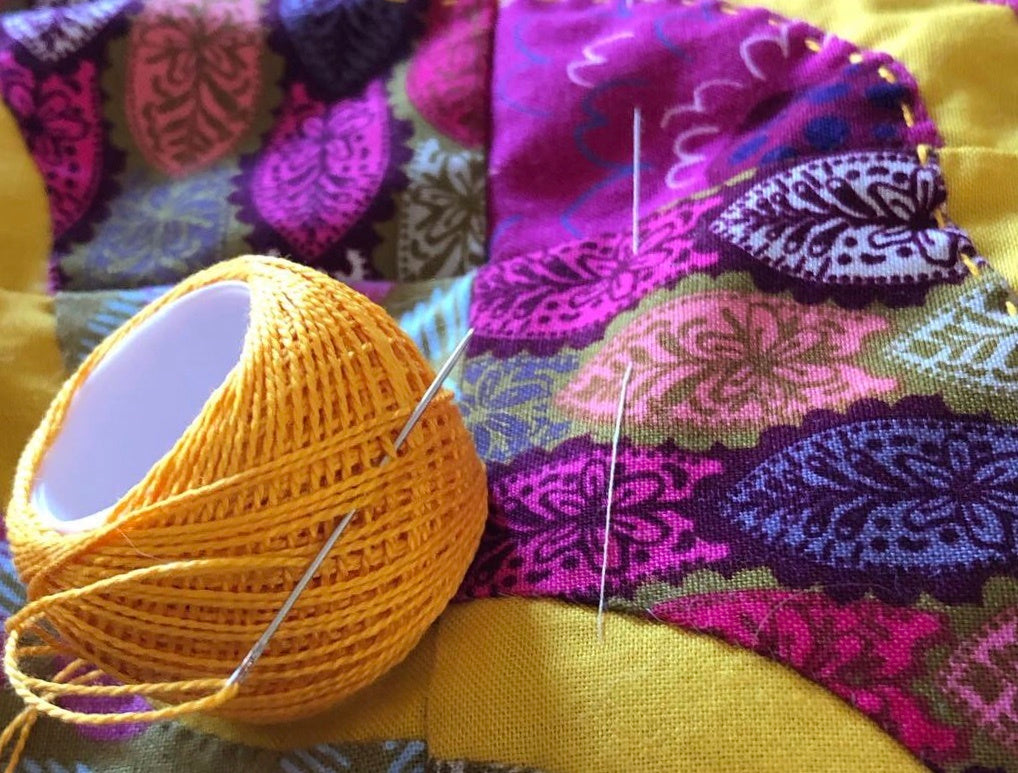
The best needles for hand sewing and quilting
People ask me what needles I use for hand sewing A LOT.
Much of it comes down to personal preference, particularly over the length of the shank. But regardless if you prefer short or long needles, using the right needle for the job sets you up for a really enjoyable sew, and will even improve the quality of your stitches.
I am very grateful to have two well-known and published embroiderers in my family: Diana Lampe and Annette Rich.


Diana and Annette are my Mum's cousins, and Netty in particular taught me a lot about how to choose needles for different types of hand sewing.
I am a bit of a needle nerd and will often pick up a packet of new needles to try, but I always seem to come back to Jeana Kimball's Foxglove Cottage needles.
I love them because:
- the quality is top notch,
- they don't bend or break easily which is pretty important when hand quilting
- they are great value for money, and
- the polished surface is really durable, so they don't get that tacky feel on the shank where the core steel gets exposed with wear.
This is one of my pet peeves with some other needles, and it happens a lot with a prettily packaged Japanese brand. It prevents the needle gliding through the fabric - Grrr!
I'm pretty excited to now stock a selection of Foxglove Cottage needles as they haven't always been easy to find in Australia. There's a selection of different types and a variety of sizes to choose from and you can check them all out here.
There are oodles of specialty needles out there to try, but here I am just focusing on the ones that I think are the best for the different hand-stitching tasks in patchwork and quilting.
The best needles for applique and piecing
There are two types of needles that I recommend for all hand piecing and hemming. They're called Sharps or Straws.

Sharps (Applique)
Sharps are sometimes also called Applique needles and will suit people who prefer a short needle. You can see one on the left in the image above.
They are fine and sharp so are a good general-purpose hand sewing needle and their shorter shank makes them more maneuverable. The eye is punched within the shank, it so it will glide smoothly through the layers of fabric without that annoying 'popping' at the eye end.
I'm a short needle gal so Sharps in Size 10 are my personal choice for EPP, American hand piecing, applique and stitching down binding.
Straws (Milliners)
Straws are the perfect piecing needle for people who prefer a longer needle. Like the Sharps they have a small eye, but the fine shank is proportionately longer.
Straws or Milliners are loved by EPP specialists like Sue Daley and Sharon Burgess of Lilabelle Lane for the way they pick up the folded edge of fabric. Straws are also the best needle to use for beading and bullion stitch embroidery as the beads and wraps of thread pass smoothly over that small eye and don't get snagged.

You can see the difference between the two types in this image, where the Sharps (size 10) is on the left and Straws to the right The size 11 straw in the middle is the smallest guage (ie the finest), yet is quite a bit longer than Sharps.
TIP: The size or gauge of needles is tricky. The bigger the size number, the smaller the needle.
The best needles for big-stitch quilting
When I first tried to hand quilt using perle 8 thread I struggled to find a needle which was fine enough to be enjoyable to use, but thick and sturdy enough to carry the thicker thread and stand up to the pressure of the rocking motion of hand quilting. I tried and discarded a lot until stumbling across the Foxglove Cottage brand.

Redwork/Embroidery Needles
Redwork/Embroidery needles tick all the boxes for me when it comes to hand quilting with Perle thread . They also meet the specialized needs of decorative stitching particularly stem stitch and back stitch.
The shank of the embroidery/redwork needle is thicker and stronger than Straws or Sharps, but is a shorter option than the Utility Quilting needles. The eye is tapered to accommodate thicker threads or mutliple strands of embroidery floss, yet still delivers a smooth stitching experience.
Because I like short needles, the size 10 Embroidery/Redwork needle is my favourite when working big-stitch quilting. If you are concerned about threading, then you might want to try the size 8.

Utility Quilting needles
Utility Quilting needles are the ones which Jeana Kimball recommends when hand quilting with perle thread and they are really popular with quilters in the US, Just like the Embroidery/Redwork needles they are strong and sturdy with a larger eye, but they are a longer option. This makes them great for loading multiple stitches and we have them in Size 8 and 10.
The shank is also a little thicker than the Embroidery/Redwork needles so they are a great choice if you want to use an even thicker thread such as perle thread.

Here you can see the Embroidery/Redwork and Quilting Utility needles side-by-side.

The big-boy needles for quilt-tying and basting
Longs/Basting needles
These needles are used to baste quilt's layers together prior to hand quilting. The slender shaft means they move smoothly through the layers, while the generous length (3 and 3.5-inches long) promotes speedy basting. The sampler packs contain two needles in these different sizes:

Longs/Tying needles

When you put the basting longs next to the tying longs you can compare the difference in the size of the needles and also just how sturdy those tying ones are. You would be able to use DK thread to tie your quilt if desired.

Have trouble threading your needles?
And last of all here are a couple of tips for threading thick thread or yarn
First up, cut your thread at an angle. The tapered point will be easier to thread than a blunt end. I also find it helps to moisten the end and flatten the thread by running it between my fingernails.




Comments
Leave a comment